Walking through the streets of Emilia-Romagna is like turning the pages of an ancient book, where each statue tells a story of heroes, artists, and visionaries who have marked the history of this wonderful region of Italy.
Placed along streets or at the center of squares, these figures in stone and bronze transcend being mere urban ornaments; they stand as silent guardians of legends and memories, eternal witnesses to a rich and vibrant past.
The statue of Neptune - Bologna

Located in Piazza del Nettuno, next to the majestic Piazza Maggiore, the Fountain of Neptune – nicknamed “Il Gigante” (Żigànt in the local dialect) by the Bolognese – is undoubtedly one of Bologna‘s most iconic monuments.
Commissioned in 1563 by Cardinal Legate Carlo Borromeo, the monument was designed by architect Tommaso Laureti and sculpted by the renowned Flemish artist Jean de Boulogne, better known as Giambologna. Inaugurated in 1566, the fountain features the imposing and proud sea god Neptune, who dominates a water basin surrounded by mythological figures.
With his trident raised, Neptune appears to control the waters, symbolizing the power and influence of the city of Bologna, which in past centuries prospered thanks to its canals and maritime trade.
Fun Facts
It is said that when viewed from a certain angle, the thumb of Neptune’s outstretched hand appears phallic, a detail that would have amused Giambologna and continues to bring a smile to passersby today. Additionally, the trident of the statue was adopted as the symbol of the Maserati car company.
I Cavalli del Mochi - Piacenza

In Piazza Cavalli in Piacenza, two equestrian statues immediately capture the attention of visitors. These monuments, known as the Cavalli del Mochi, are an undisputed masterpiece of Baroque sculpture and have since become one of the city’s distinctive symbols.
Created by the Tuscan sculptor Francesco Mochi from Montevarchi, who dedicated sixteen years (from 1612 to 1628) to their creation, they were commissioned by Ranuccio I Farnese, lord of Parma and Piacenza, to honor the memory of his father Alessandro Farnese and to restore the favor of the people of Piacenza towards his family.
Ranuccio Farnese is depicted on the right with incredible dynamism, in Roman costume and holding a scepter, while the horse seems to come to life beneath him. Alessandro Farnese, Ranuccio’s father, is portrayed in a calmer and more majestic posture, reflecting his nature as a leader and strategist.
Fun Facts
During World War II, in 1944, the two equestrian statues were moved inside the Castle of Rivalta to protect them from possible damage during the bombings.
The Statue of Giuseppe Verdi - Busseto
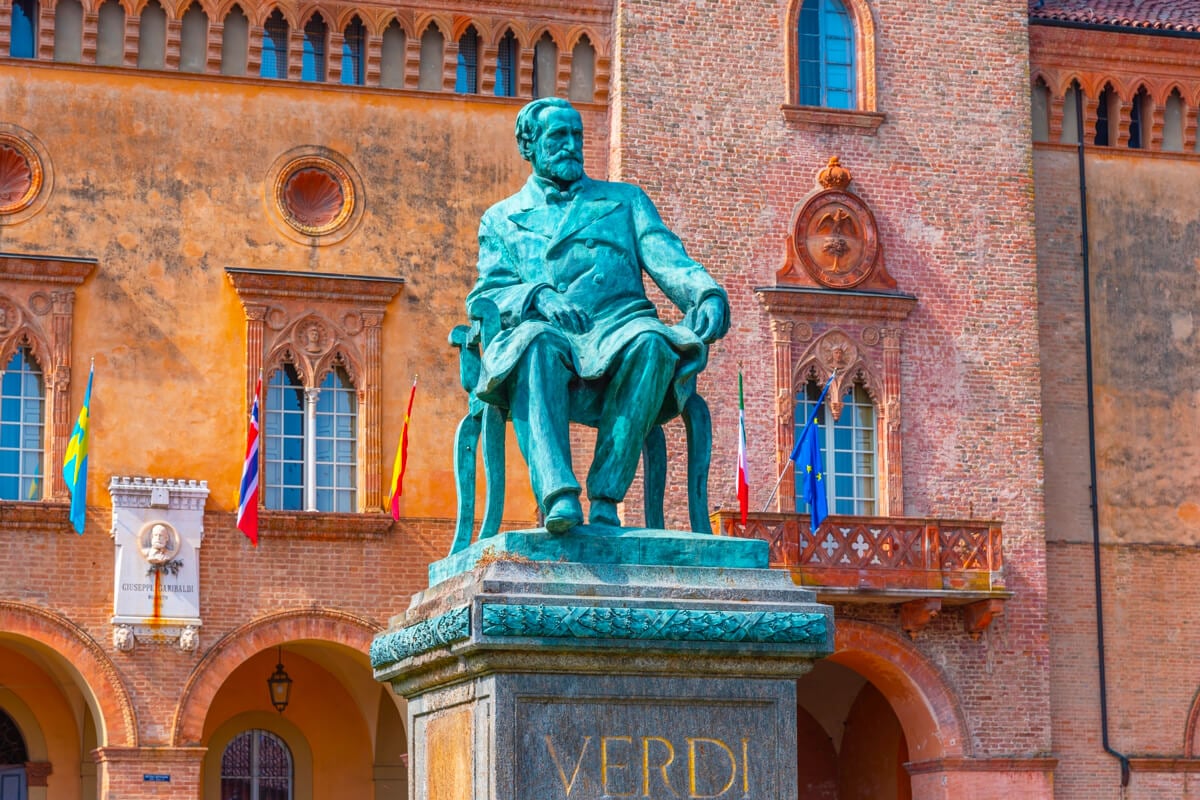
The great Giuseppe Verdi, known as one of the most celebrated opera composers in the world, was born in the small locality of Le Roncole in 1813, a hamlet of Busseto (PR). His hometown could not avoid celebrating one of its finest “sons” with a bronze statue located in the main square of Busseto, in front of the Rocca.
The work was created by the Cremonese sculptor Luigi Secchi, whose project was selected by architects Luca Beltrami and Camillo Boito on the occasion of the centenary of Giuseppe Verdi’s birth. The inauguration took place on October 9-10, 1913.
The Maestro, depicted in a seated and thoughtful position, seems to quietly oversee the life of the town, almost reflecting on his immortal works. It is a tribute to his extraordinary career and his unparalleled contribution to the world of opera music.
Fun Facts
Every year, this square comes alive during the Festival Verdi, when enthusiasts and musicians from all over the world gather to celebrate his legacy. The statue thus becomes the focal point of a vibrant cultural experience, a place where Verdi’s art continues to resonate, evoking deep and timeless emotions.
Not to be forgotten, in nearby Parma, in Piazza San Francesco, right in front of the Casa della Musica, there is another sculpture dedicated to Giuseppe Verdi, this time seated on a bench. The work, weighing 400 kilograms, was created by the artist Sergio Brizzolesi on the occasion of the Bicentennial of the great Maestro’s birth.
The statue of the Crostolo - Reggio Emilia
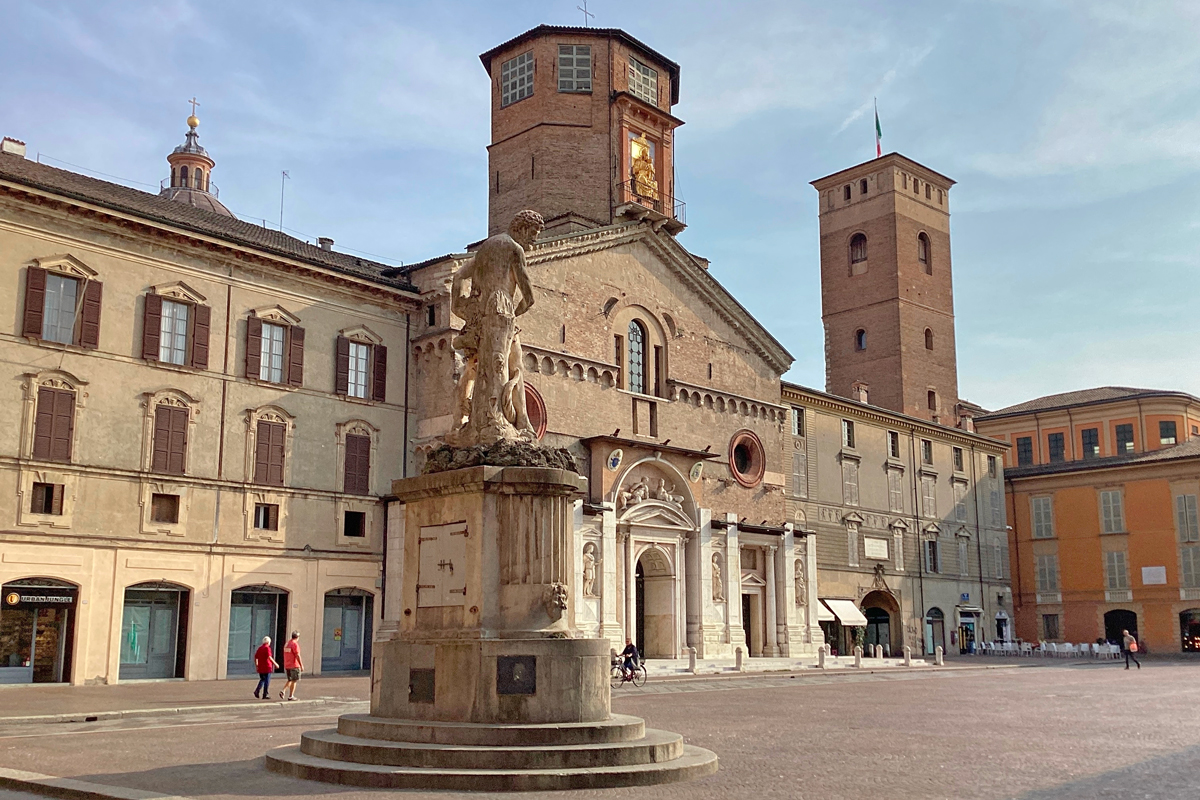
Situated on one side of Piazza Prampolini in Reggio Emilia, along the historical course of the Crostolo stream, the Statue of the Crostolo allegorically represents the waterway itself.
It is one of the city’s most emblematic symbols and a gathering place for its inhabitants. The sculpture, with its classical elegance, invites visitors to reflect on the profound connection between humans and nature, celebrating the stream that has sustained and given life to generations of Reggio Emilia’s residents.
Fun Facts
Along with the statues of the Secchia and Panaro rivers, the Statue of the Crostolo originally was part of the ornamental complex of the Ducal Villa Park in Rivalta, where it was documented as early as 1754. It was subsequently moved to this location in 1800, placed near a well constructed in 1770 by the Cathedral clergy for water supply purposes.
The Bonissima - Modena

The Statue of Bonissima, situated in a corner of the Palazzo del Comune in Modena, is one of the city’s most intriguing icons. This enigmatic female figure, sculpted in the Middle Ages and dated between the 12th and 13th centuries, is shrouded in mystery and legends.
Various hypotheses have been formulated regarding her identification. According to one legend, she was a noble lady named Bona who, during a time of famine, endeavored to help the poor. Scholars unanimously agree that La Bonissima represents a real historical figure, but they are divided on her precise identity. Some believe she was “Bonixima, daughter of a certain Sigecio” , while others think she might be Gundeberga, a Lombard woman.
Others have attempted to identify the statue with Countess Matilda of Canossa, who held considerable influence and authority in the city at that time. Lastly, some scholars suggest that the statue does not represent a physical person but rather a public office of the municipality, of which it was an emblematic symbol: the Office of Good Reputation, also known as the Office of Weights and Measures, in front of which it was originally placed. A possible confirmation of this theory could be the fact that the slab supporting the sculpture was inscribed with all the local commercial measures.
Fun Facts
The statue seems to silently observe the activities of the square below, as if to remind the people of Modena of the importance of justice and compassion.
Its immobile and solemn presence has become a landmark for the inhabitants of Modena, enchanting visitors with its enigmatic gaze and its role in the historical and cultural fabric of the city.
The Statue of Guercino - Cento
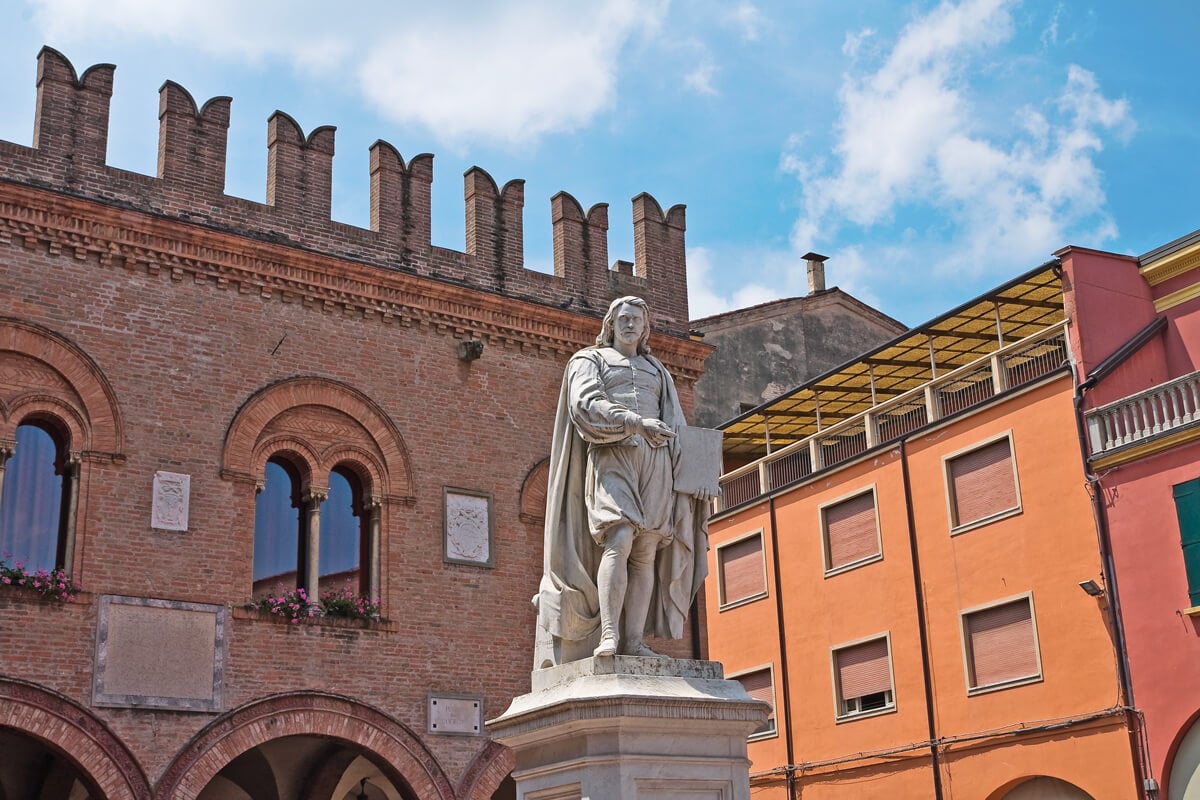
Born in 1591 in Cento (Ferrara), Giovanni Francesco Barbieri, better known as Guercino, distinguished himself for his technical skill, the emotional depth of his works, and his unparalleled mastery of light. He is recognized by critics as one of the most important and influential Italian painters of the 17th century.
In the heart of his hometown, in the main square named after him (Piazza Guercino), the citizens of Cento wanted to pay tribute to his talent and artistic influence by erecting a beautiful statue in 1862.
The sculpture, created by the young artist Stefano Galletti, is a touching and enduring homage to the Baroque master. The statue depicts the artist in a thoughtful and dignified pose, with one hand holding a brush and the other supporting a palette, symbolic tools of his trade. His gaze seems to look towards the horizon, as if immersed in contemplation of his future works.
Fun Facts
The statue serves as a gathering point for residents and often becomes the focal point of local celebrations, such as the famous Fiera di Cento or the grand carnival. To better appreciate the artistic work of the painter, a visit to the Civica Pinacoteca il Guercino is indispensable.
It houses a priceless collection of 120 works, including paintings and sculptures, 46 drawings, and 20 frescoes, all created by the hand of Giovanni Francesco Barbieri.
The statue of Girolamo Savonarola - Ferrara
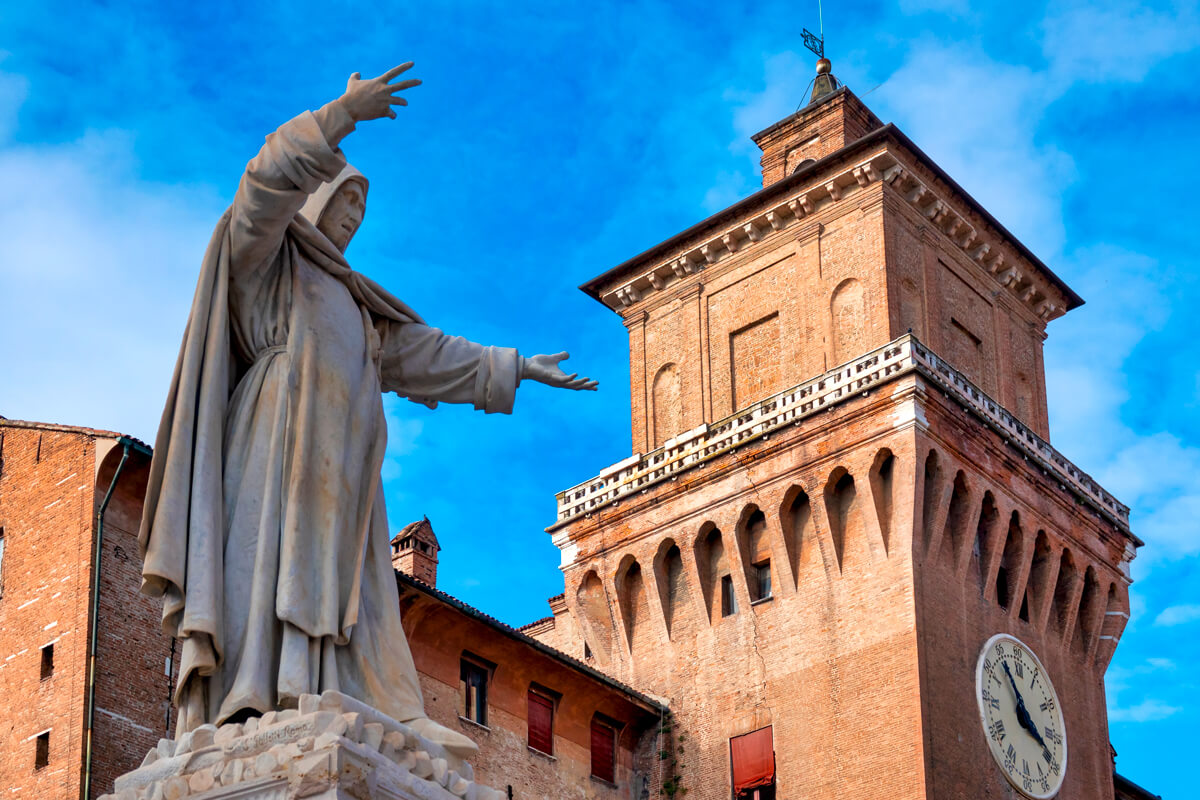
Located in Piazza Savonarola in Ferrara, at a pivotal point in the historic center, the Statue of Girolamo Savonarola depicts the famous Dominican friar known for his fervent sermons against the moral and political corruption of the Renaissance
His passionate denouncements led to a turbulent and dramatic life, culminating in his condemnation to death by burning. The statue was erected in 1875 following a national competition won by Stefano Galletti, the same artist responsible for the statue dedicated to Guercino in nearby Cento.
The work, made of white Carrara marble, reaches a height of 2.90 meters and rests on a base of alternating white and red Verona marble, 4.20 meters high, surrounded by twelve marble columns crafted by the artist David Venturi of Bologna.
Fun Facts
The statue, a symbol of strength and determination, reminds passersby of Savonarola’s courage in denouncing the evils of his time. His imposing figure, positioned in front of the majestic Estense Castle, still seems to admonish those who walk by today, underscoring the importance of justice and integrity.
The statue of Saint Apollinaris - Ravenna

Located in Piazza del Popolo, in the historic center of Ravenna, the statue pays homage to Saint Apollinaris, the city’s first bishop and patron saint.
The statue, placed on a very tall granite column erected in 1441 during Venetian rule, depicts the prelate in episcopal garments with a pastoral staff, symbols of his religious office. Next to him, on an identical column once occupied by the Lion of Saint Mark, stands the statue of Saint Vitalis, an early Christian martyr intimately connected to the city.
Fun Facts
The history and veneration of Saint Apollinaris are deeply intertwined with the history of Ravenna. It is no coincidence that two basilicas from the 5th and 6th centuries (Sant’Apollinare Nuovo and Sant’Apollinare in Classe), both dedicated to him, have been declared UNESCO World Heritage Sites.
Author
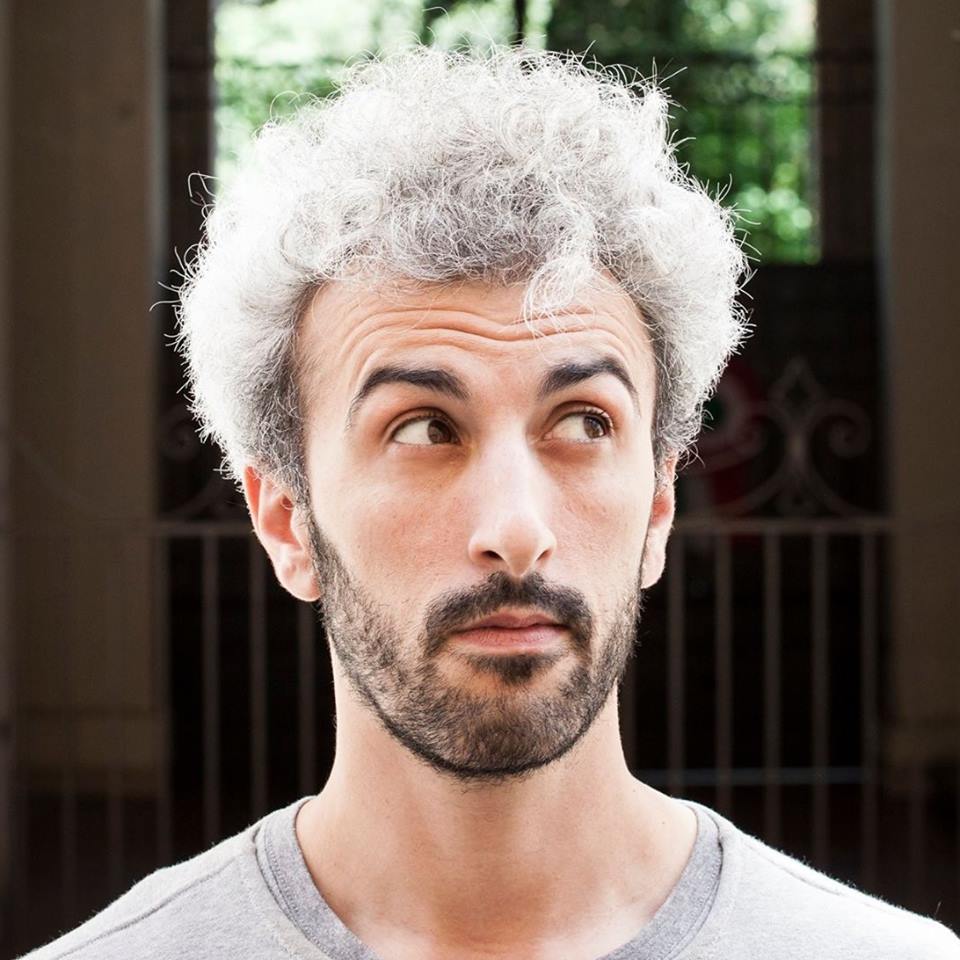
Davide Marino
Davide Marino was born archaeologist but ended up doing other things. Rational – but not methodic, slow – but passionate. A young enthusiast with grey hair